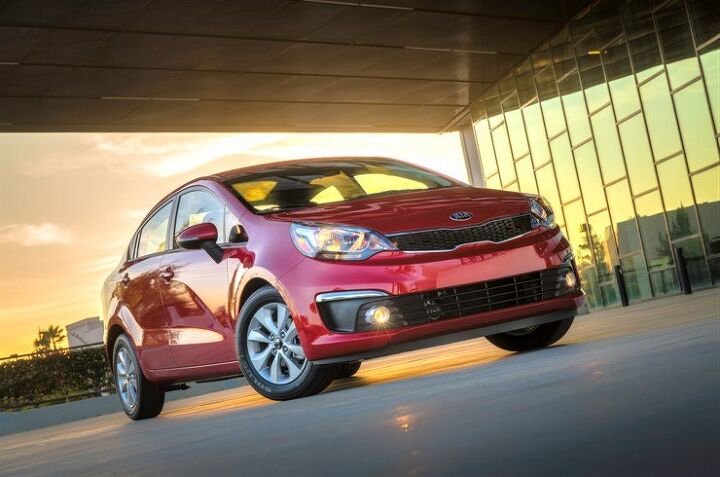Hyundai Group Riding High Amid Russian Economic Maelstrom
As Russia continues to struggle with its economic health, Hyundai Group is doing its part to keep the nation’s auto sales afloat.
According to a representative, “Russia is one of the major and important markets for Hyundai (Group),” Ward’s Auto reports. The group’s Hyundai and Kia brands hold a combined 19.9 percent of the nation’s automotive market in Q1 2015, with Hyundai holding 10.4 percent and Kia 9.5 percent.
Despite the maelstrom sweeping through the market, Hyundai Group has managed to fare well against the economic storm compared to other automakers. Analysts and industry-watchers suggest this is due to factors such as proper product placement, a beneficial global strategy, and its ability to play the game driving Russia’s auto industry.
The group also took home the gold in deliveries over the recent quarter, moving a combined 75,871 vehicles out of the showroom. Local automaker AvtoVAZ pulled up in second with 68,554 in the same period, while Renault-Nissan took bronze with 65,657 combined deliveries. Meanwhile, BMW is reconsidering plans to build a factory in Russia, and General Motors is shutting down local production and withdrawing its Chevrolet and Opel brands from the market.
Within the group, the Kia Rio has done wonders for the bottom line, especially for the Kia brand. Produced locally at the Hyundai Motor Manufacturing Russia facility in St. Petersburg, the Rio accounted for 44 percent of overall production — 104,700 units — and 48 percent of all the brand’s sales in the market during 2014.
Though the country’s economic woes are expected to worsen in 2015, a Kia representative says market share for the brand is likely to continue trending upward, having gone from 7.1 percent in 2013 to 7.9 percent last year; current projections through February 2015 point to a 9.8-percent share by the end of the year. Hyundai remains mum on yearly forecasts, but believes it will continue to fare well, also, thanks in part to government incentives for both consumers and the industry as a whole.
[Photo credit: Kia]
Seattle-based writer, blogger, and photographer for many a publication. Born in Louisville. Raised in Kansas. Where I lay my head is home.
More by Cameron Aubernon
Latest Car Reviews
Read moreLatest Product Reviews
Read moreRecent Comments
- ToolGuy I do like the fuel economy of a 6-cylinder engine. 😉
- Carson D I'd go with the RAV4. It will last forever, and someone will pay you for it if you ever lose your survival instincts.
- THX1136 A less expensive EV would make it more attractive. For the record, I've never purchased a brand new vehicle as I have never been able to afford anything but used. I think the same would apply to an EV. I also tend to keep a vehicle way longer than most folks do - 10+ years. If there was a more affordable one right now then other things come to bear. There are currently no chargers in my immediate area (town of 16K). I don't know if I can afford to install the necessary electrical service to put one in my car port right now either. Other than all that, I would want to buy what I like from a cosmetic standpoint. That would be a Charger EV which, right now, doesn't exist and I couldn't afford anyway. I would not buy an EV just to be buying an EV. Nothing against them either. Most of my constraints are purely financial being 71 with a disabled wife and on a fixed income.
- ToolGuy Two more thoughts, ok three:a) Will this affordable EV have expressive C/D pillars, detailing on the rocker panels and many many things happening around the headlamps? Asking for a friend.b) Will this affordable EV have interior soft touch plastics and materials lifted directly from a European luxury sedan? Because if it does not, the automotive journalists are going to mention it and that will definitely spoil my purchase decision.c) Whatever the nominal range is, I need it to be 2 miles more, otherwise no deal. (+2 rule is iterative)
- Zerofoo No.My wife has worked from home for a decade and I have worked from home post-covid. My commute is a drive back and forth to the airport a few times a year. My every-day predictable commute has gone away and so has my need for a charge at home commuter car.During my most recent trip I rented a PHEV. Avis didn't bother to charge it, and my newly renovated hotel does not have chargers on the property. I'm not sure why rental fleet buyers buy plug-in vehicles.Charging infrastructure is a chicken and egg problem that will not be solved any time soon.


































Comments
Join the conversation
So how do they make money while others don't? Renault-Nissan has local factories, and I thought GM had, too? That partially offsets the trouble with the rouble, but why would just one conglomerate know how to navigate these seas?
Hyundai and Kia are very aggressive on pricing here. I currently have the new Kia Rio ( Chinese model is the one sold here ) advertised for 535,000 руб. Whereas the the Hyundai Solaris ( accent ) looks to be for sale for 10,000 руб. less. If you compare this to lada and Renault / Nissan they cost about 100,000 more. But are still quite affordable. I could see a Russian having no problem spending slightly more for better perceived value. The ruble also had been gaining traction and it's value add risen quite dramatically. Just yesterday it dropped below 50 Rub per USD.